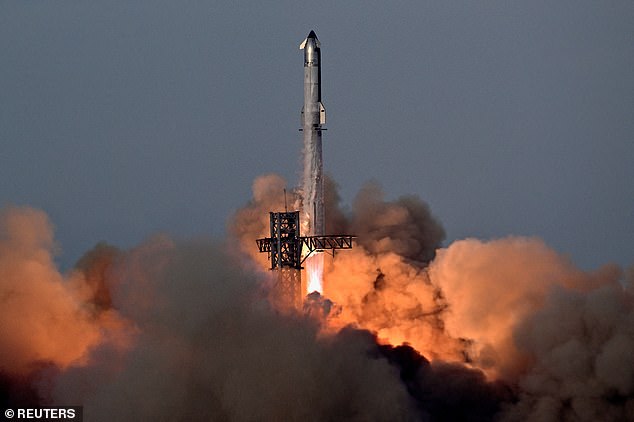SpaceX earned a much-needed win on Tuesday with the successful launch of its Starship rocket following a series of failures that ended in disaster.
The 403-foot-tall rocket blasted off from Starbase – SpaceX’s launch site in South Texas – right as the launch window opened at 6.30pm local time for the tenth flight test.
As it crept into the air, engineers on the ground could be heard in a live stream cheering their success.
Once in the air, the rocket successfully separated from its Super Heavy Booster and achieved its desired suborbital trajectory, from where it opened up like a PEZ dispenser and deployed eight dummy satellites while the Super Heavy Booster splashed back down in the Atlantic.
The Starship then continued to orbit the Earth – passing from daylight in Texas through night and back into daytime again- before it landed on the ocean’s surface west of Australia just over an hour after its launch.
Just before it hit the waves, the craft’s engines fired, flipping its position so it would enter the Indian Ocean upright with its nose cone pointed upwards.
But the 171-foot-tall Starship then toppled over and exploded into a giant fireball – though SpaceX executives say it was an expected demise for the ship that was likely triggered by its flight termination system.
The only issue seemed to occur as the rocket made its way back into the atmosphere, when a chunk of the ship’s skirt broke apart – and sent debris into space.

The 403-foot-tall Starship blasted off from Starbase – SpaceX’s launch site in South Texas – right as the launch window opened at 6.30pm local time for the tenth flight test on Tuesday

Once in the air, the rocket successfully separated from its Super Heavy Booster and achieved its desired suborbital trajectory
‘This was absolutely incredible,’ SpaceX Build Reliability Engineer Amanda Lee said during live launch commentary, according to Space.com.
‘A huge congrats to all the teams here,’ she added.
SpaceX CEO Elon Musk also took to his X social media platform.
‘Great work by the SpaceX team,’ he wrote.
The successful demo came after a year of mishaps.
Back-to-back tests in January and March ended just minutes after liftoff with the ship exploding in mid-air.
The most recent launch effort in May – the ninth try – ended when the spacecraft tumbled out of control and broke apart over the Indian Ocean.
In that instance, the Super Heavy booster suffered a catastrophic failure when its engines reignited for splashdown.

It successfully splashed down in the Indian Ocean just over an hour after takeoff

Residents of South Padre Island gathered to watch the launch on Tuesday
SpaceX confirmed the loss of the booster but noted the failure was expected given the extreme test conditions.
Earlier that month, a static fire test on the 35th iteration of the Starship rocket suffered a fiery fate when an object flew out of the ‘flame trench’ – a deep channel below the launchpad designed to deflect flames generated by the boosters.
Then in June, the 36th iteration of Starship was undergoing a static fire test at the Starbase test site when shocking footage showed its nose suddenly bursts open – causing the screen to momentarily flash white.
When the light finally faded, a giant ball of fire could be seen spreading on the ground as black clouds of smoke reached up to the night sky.

In June, the 36th iteration of Starship was undergoing a static fire test at the Starbase test site when shocking footage showed its nose suddenly bursts open
But SpaceX executives say they have learned from each of those failed tests.
The company has traced the ship’s flight nine problems in May to a failure of the vessel’s main fuel tank pressurization system diffuser.
Engineers have since redesigned the system ‘to better direct pressurized gas into the main fuel tank and substantially decrease the strain on the diffuser structure,’ SpaceX wrote in a report.
It also determined that the explosion in June was due to undetected damage on a composite overwrapped pressure vessel in the ship’s payload bay section.
‘To address the issue, COPVs on upcoming flights will operate at reduced pressure with additional inspections and proof tests added prior to loading reactive propellants onto a vehicle,’ the company wrote in its report on the ninth test flight, which also addressed the failed static fire test in June.
It added that the company developed a ‘new non-destructive evaluation method to detect internal COPV damage.’
SpaceX also redesigned the Super Heavy booster with larger and stronger fins for greater stability, according to a company post on the social platform X this month.

SpaceX CEO Elon Musk hopes to one day use the rockets to colonize Mars
It now seems that the modifications to the rocket proved successful.
‘We probably gave it a little bit of extra time in the oven but made it all the way through re-entry,’ SpaceX spokesman Dan Hout said during Tuesday night’s livestream.
‘We promised maximum excitement, Starship delivered,’ he added.
Hout said engineers at the rocket company will now go through all of the data from the tenth launch as they aim to get Starship ready to bring astronauts back to the moon and ultimately meet Musk’s goal of colonizing Mars.
The company is also counting on the Starship rockets to finish building out its Starlink megaconstellation, which is already the largest satellite network ever assembled.
In the meantime, though, Hout said it was ‘really crazy cool to hit all those objectives today.’
